Recent Bonsai Books Offer Local and Broader Perspectives
These books profile, or are written by, three of the best-known artists in the American bonsai community. Two of the artists are based in the Puget Sound region.
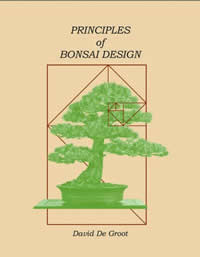 David De Groot was the curator of the Pacific Rim Bonsai Collection (now the Pacific Bonsai Museum) in Federal Way for 25 years, until his retirement in 2014. His book Principles of Bonsai Design is the long-awaited new and expanded version of his 1995 classic Basic Bonsai Design. In his new book the author enlarges on his view that bonsai should be considered as a fine art rather than a horticultural novelty. Interestingly, he was a classical musician before becoming a bonsai practitioner, and is a collector of Asian art. There is little information here about how to train trees as bonsais or how to care for them. The emphasis is on choosing a design that references nature, but is a work of art in its own right. The book has many very clear drawings illustrating his points about proportion, balance, container selection and display options. Photographs show examples of trees in nature that can act as inspirations for bonsai design. This is not the book to page through for awe-inspiring pictures of bonsai, but rather to use as a reference when deciding how to convert starting plant material into an aesthetically-pleasing bonsai.
David De Groot was the curator of the Pacific Rim Bonsai Collection (now the Pacific Bonsai Museum) in Federal Way for 25 years, until his retirement in 2014. His book Principles of Bonsai Design is the long-awaited new and expanded version of his 1995 classic Basic Bonsai Design. In his new book the author enlarges on his view that bonsai should be considered as a fine art rather than a horticultural novelty. Interestingly, he was a classical musician before becoming a bonsai practitioner, and is a collector of Asian art. There is little information here about how to train trees as bonsais or how to care for them. The emphasis is on choosing a design that references nature, but is a work of art in its own right. The book has many very clear drawings illustrating his points about proportion, balance, container selection and display options. Photographs show examples of trees in nature that can act as inspirations for bonsai design. This is not the book to page through for awe-inspiring pictures of bonsai, but rather to use as a reference when deciding how to convert starting plant material into an aesthetically-pleasing bonsai.
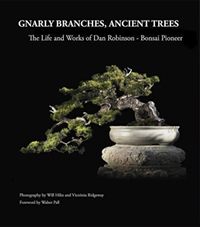 The second book, Gnarly Branches, Ancient Trees profiles the life and work of Dan Robinson, written by a friend and fellow bonsai enthusiast, Will Hiltz, with additional photography by Victrinia Ridgeway. Dan Robinson is the owner of Elandan Gardens near Bremerton and is known to many local residents through his display gardens at the Seattle Flower and Garden Show. He trained in forestry and worked for many years as a landscaper. This work, and his posting to Korea while serving in the army in the 1960’s, inspired an interest in bonsai. His bonsai creations are highly original—naturalistic and free-form, in contrast to the refined style of traditional Japanese bonsai. Many originated with trees collected locally from sites where they were surviving under stress, such as in bogs or on rocky mountain peaks. The appeal of this book is not just the story of a local personality in the bonsai community, but also the beautiful photography of the bonsais he has created.
The second book, Gnarly Branches, Ancient Trees profiles the life and work of Dan Robinson, written by a friend and fellow bonsai enthusiast, Will Hiltz, with additional photography by Victrinia Ridgeway. Dan Robinson is the owner of Elandan Gardens near Bremerton and is known to many local residents through his display gardens at the Seattle Flower and Garden Show. He trained in forestry and worked for many years as a landscaper. This work, and his posting to Korea while serving in the army in the 1960’s, inspired an interest in bonsai. His bonsai creations are highly original—naturalistic and free-form, in contrast to the refined style of traditional Japanese bonsai. Many originated with trees collected locally from sites where they were surviving under stress, such as in bogs or on rocky mountain peaks. The appeal of this book is not just the story of a local personality in the bonsai community, but also the beautiful photography of the bonsais he has created.
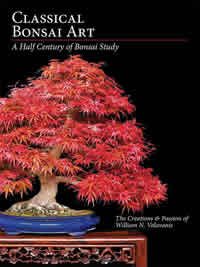 Finally, Classical Bonsai Art by William N. Valavanis is both an introduction to the basic techniques and design of bonsai, and also a detailed description of the development of 100 of his bonsai creations over several years. The author is the founder of the International Bonsai Arboretum in Rochester, New York, the organizer of several U.S. National Bonsai Exhibitions and a nationally known bonsai teacher. He relates that his interest in bonsai began when he was 11 years old, and continued through his undergraduate studies in ornamental horticulture. He subsequently made many trips to Japan and apprenticed with famous bonsai masters there. The most fascinating aspect of the book is the insight it gives into the way the author plans a design from his starting material and then manipulates the tree to achieve his goal. He documents the process with detailed photographs often spanning periods of up to 30 years. Along the way we see how he tried out various containers or different orientations of the tree. Each sequence ends with a beautifully-staged photograph of the bonsai in its current state.
Finally, Classical Bonsai Art by William N. Valavanis is both an introduction to the basic techniques and design of bonsai, and also a detailed description of the development of 100 of his bonsai creations over several years. The author is the founder of the International Bonsai Arboretum in Rochester, New York, the organizer of several U.S. National Bonsai Exhibitions and a nationally known bonsai teacher. He relates that his interest in bonsai began when he was 11 years old, and continued through his undergraduate studies in ornamental horticulture. He subsequently made many trips to Japan and apprenticed with famous bonsai masters there. The most fascinating aspect of the book is the insight it gives into the way the author plans a design from his starting material and then manipulates the tree to achieve his goal. He documents the process with detailed photographs often spanning periods of up to 30 years. Along the way we see how he tried out various containers or different orientations of the tree. Each sequence ends with a beautifully-staged photograph of the bonsai in its current state.

In this morning’s edition of “The Seattle Times” (February 24, 2017), I was interested to see an Associated Press article by Matti Huuhtanen about an “Arctic ‘doomsday’ seed vault.” This refers to the Svalbard Global Seed Vault that is also the subject of a new book in the Miller Library, Seeds on Ice.
The Miller Seed Vault, located in the Douglas Research Conservatory, is the largest of its kind in the Pacific Northwest and preserves more than 320 rare plant species from Washington. By comparison, the Svalbard Vault has over 4,000 species of food or agriculture crops from around the world. For most species, the vault also protects many, many selected varieties.
This book tells the short history (it opened in 2008) of the Svalbard Vault, its operations, and its location in the far north of Norway (with many stark and beautiful photographs). It also tells the chilling story of its first withdrawal by an agricultural research institution in Syria, that fortunately sent seeds to Svalbard just before hostilities erupted in that country. Fortunately, those withdrawn seeds are now being grown outside of Syria to replenish the original stock.
Published in the March 2017 Leaflet for Scholars Volume 4, Issue 3.

Teacher Laurie Rubin weekly features nature study in her elementary school classes in Ithaca, New York, in part based on an idea developed by Jon Young and instructors at the Wilderness Awareness School in Duvall, Washington. Rubin’s child-centered program integrates critical thinking skills in science, mathematics, and language arts across the seasons of the year in the great outdoors.
In her program, once a week the students investigate a particular place, in whatever weather, in the natural environment near the school – a creek. Students discover that the creek experience is never the same twice. They have grown and developed, and the creek environment keeps changing over time. They keep journals of their observations, looking closely at plants, birds, insects, weather, and more. Stewardship of the natural world inspired at an early age is destined to last a lifetime.
Lo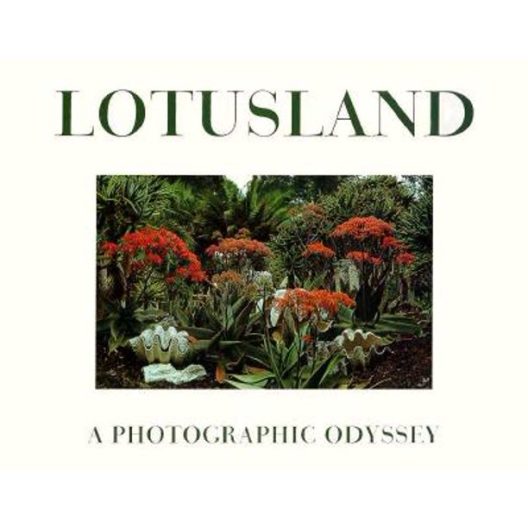 tusland, a garden near Santa Barbara, California, inspires photographers. Its creator, Madame Ganna Walska, inspired writers and photographers. Many books, chapters of books, and magazine articles in the Miller Library use words and images to tell the amazing stories of both the garden and its maker.
tusland, a garden near Santa Barbara, California, inspires photographers. Its creator, Madame Ganna Walska, inspired writers and photographers. Many books, chapters of books, and magazine articles in the Miller Library use words and images to tell the amazing stories of both the garden and its maker.
My favorite of the books is Lotusland: A Photographic Journey (1995). As the title suggests, this is an art book. Captions are in an appendix so they do not distract from the images. The work of three principle photographers combines with historical pictures to give a wide range of close-ups, landscapes, and vistas – all curated into an outstanding exhibit.
Popping up here and there is the text by author Theodore Roosevelt Gardner II. He is at his liveliest in a chapter on the six husbands of Madame Walska.
He writes, “Through the kindness of time, the husbands of Madame Ganna Walska have become statistics. A book or more could easily be written about each one of them…” What follows is a field guide to these men, with all the vital details including occupation, his (and her) age at the time of marriage, the estimated length of courtship (usually very short), and, perhaps most important, the financial settlement at the end of the marriage.
Published in Garden Notes: Northwest Horticultural Society, Spring 2017

In the opening chapter of Urban Tree Management, editor Andreas Roloff introduces the common problems associated with trees growing in the public spaces of cities. He quickly dismisses these by concluding: “…the positive aspects are always likely to prevail. The occasional inconvenience caused by trees should therefore be tolerated.”
This no-nonsense approach is typical of this collection of essays by numerous German experts that Roloff, the chair of Forest Botany at Dresden University of Technology, has collected. Of course – the authors would agree – trees are essential to cities!
While this attitude may represent an especially German viewpoint, I believe it will resonate with local arborists and others who care for the trees in city landscapes. In later chapters, the problems the editor initially presents, and many more, are addressed pragmatically and in considerable detail.
The result is an excellent reference book. All aspects of tree health, maintenance, and selection are considered. Potential issues with governing bodies and conflicts with human activities are discussed. The educational, social, and public health benefits of urban trees are championed.
This book is somewhat rare in this country, so is for library use only. However, each chapter includes an extensive list of references, most in English, and many that are readily available in print or online. For another positive review and perspective on the value of this book, see the article by Julian Dunster in the Summer 2016 issue of Pacific Northwest Trees. It’s available in the library, or online via the Pacific Northwest International Society of Arboriculture website.
Published in the February 2017 Leaflet for Scholars Volume 4, Issue 2.
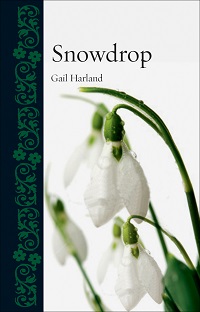
A few months ago, when I was considering potential books for the Miller Library, my first reaction to Snowdrop by Gail Harland was, “Oh no, we don’t need another book on snowdrops!”
I was wrong. This is an excellent addition to the library and is quite different from our several other titles on the genus Galanthus. It is part of the Reaktion Books Botanical series of books (we have many in the series) which are uniform in their ability to bring a fresh prospective to many garden subjects already well recounted by others.
These other authors provide extensive descriptions of the hundreds of snowdrop varieties that eager galanthophiles will snap up, while this book is more interested in the passion that drives such collectors. It is also a wonderful history of the role these early spring flowers have played in culture, including art, literature, and music.
For example, do you remember the white kitten in Through the Looking Glass and What Alice Found There? Yes, that was Snowdrop, who later became the White Queen. Did you know that earliest English translations of Schneewittchen by the Brothers Grimm was Snow-Drop? It was only after the Walt Disney animation of the same story that we came to know the heroine as Snow White.
For these stories and many others, this is a delightful book to read especially during these late, cold days of winter. Moreover, if you hurry, you can check out Snowdrop while its eponymous flower is still in bloom in your garden!
Published in the February 2017 Leaflet Volume 4, Issue 2.
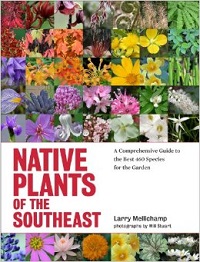
In the spring of 2014, I visited the North Carolina Botanical Garden in Chapel Hill, NC. I was delighted by this extensive collection of herbaceous and woody plants mostly native to the southeastern United States. Many of these plants, or their close relatives, can thrive in our Pacific Northwest gardens.
These are featured in a book that was published later in 2014: Native Plants of the Southeast. Author Larry Mellichamp is the retired director of the botanical garden at the Charlotte campus of the University of North Carolina and has considerable experience with plants throughout the temperate southeast.
This book is much more than a field guide. Each plant is evaluated for garden cultivation. An extensive introduction discusses the merits and challenges of using native plants in a landscape, with principles that would be applicable in our region. The plant encyclopedia is interspersed with essays on broad groupings of plants with an emphasis on garden adaptability.
If this book sparks your interest in this region, consider visiting! The University of Washington Botanic Gardens is leading a trip to Savannah, Georgia and Charleston, South Carolina this coming March. All the details are online, but hurry – reservations must be received by January 19.
Published in the January 2017 Leaflet Volume 4, Issue 1.
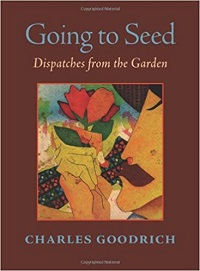
According to his website, Charles Goodrich supported his poetry and other writings with a 25-year career as a professional gardener in Corvallis, Oregon. “Going to Seed” is a fine example of his avocation. Reading through his selection of brief essays, organized by seasons, I’m keenly reminded of the many forms of life we can observe in our gardens. I was struck by this quotation from a selection by Goodrich titled “The Master.”
“It’s hard to take this bumblebee seriously, with his stubby wings, pudgy thorax, geodesic eyes. When he lifts his ponderous body in flight, he fudges several laws of aerodynamics. If this is how plants get pollinated, it’s a wonder the planet survives. Weird, how evolution flirts with absurdity.”
Excerpted from the Winter 2017 Arboretum Bulletin.

Kate Frey and Gretchen LeBuhn in “The Bee-Friendly Garden” consider all the various types of native bees found in northern California and how to create an inviting environment for them. There is a chapter on recommended bee-friendly plants, both woody and herbaceous, always with an emphasis on natives. There are lists of plants to avoid, including those with double flowers as single, pollen rich flowers have more to offer to pollinators. Thinking from the bee’s perspective, you are advised to plant more than single specimens, otherwise they “…may not have enough floral rewards to make it worthwhile.”
Providing sufficient nesting options is critical. While the authors briefly cover human-made nests and bee “hotels”, they encourage a more passive approach such as using plants that have naturally hollow stems and leaving a few logs around. They recommend leaving some bare patches of ground, free of layers of mulch that are troublesome for bees to dig through. Of course, like all wildlife, your bees need to have a pesticide-free environment.
Excerpted from the Winter 2017 Arboretum Bulletin.

Most of the bee books in the Miller Library collection are either guides to keeping honey bees, or field guides to native bees. A new book by Pacific Northwest authors has a different focus – living with bees as an active, vibrant part of your garden.
While this may include European honey bees, the focus is on less well-known native bees. Most of these are solitary bees that do not form hives or make honey, but they are outstanding pollinators. “Mason Bee Revolution” by Dave Hunter and Jill Lightner (both from the Seattle area) emphasizes the encouragement and care of Mason bees for spring pollination, followed by leafcutter bees for the summer.
To these authors, the bees are almost pets. While the care requirements are minimal compared to many other garden tasks, they still are important, and can be a fun and useful way to share bee knowledge with friends and neighbors.
You’ll learn that storing your Mason bee cocoons in the refrigerator is an ideal winter home, if you don’t mind them sharing the crisper with your salad greens. However, leafcutter bees are best a bit warmer, such as in an unheated garage. Why go to all this trouble? “Pest control is the primary reason for harvesting cocoons. We want our bees to thrive, not just survive, for next season’s pollination.”
Excerpted from the Winter 2017 Arboretum Bulletin.
 David De Groot was the curator of the Pacific Rim Bonsai Collection (now the Pacific Bonsai Museum) in Federal Way for 25 years, until his retirement in 2014. His book Principles of Bonsai Design is the long-awaited new and expanded version of his 1995 classic Basic Bonsai Design. In his new book the author enlarges on his view that bonsai should be considered as a fine art rather than a horticultural novelty. Interestingly, he was a classical musician before becoming a bonsai practitioner, and is a collector of Asian art. There is little information here about how to train trees as bonsais or how to care for them. The emphasis is on choosing a design that references nature, but is a work of art in its own right. The book has many very clear drawings illustrating his points about proportion, balance, container selection and display options. Photographs show examples of trees in nature that can act as inspirations for bonsai design. This is not the book to page through for awe-inspiring pictures of bonsai, but rather to use as a reference when deciding how to convert starting plant material into an aesthetically-pleasing bonsai.
David De Groot was the curator of the Pacific Rim Bonsai Collection (now the Pacific Bonsai Museum) in Federal Way for 25 years, until his retirement in 2014. His book Principles of Bonsai Design is the long-awaited new and expanded version of his 1995 classic Basic Bonsai Design. In his new book the author enlarges on his view that bonsai should be considered as a fine art rather than a horticultural novelty. Interestingly, he was a classical musician before becoming a bonsai practitioner, and is a collector of Asian art. There is little information here about how to train trees as bonsais or how to care for them. The emphasis is on choosing a design that references nature, but is a work of art in its own right. The book has many very clear drawings illustrating his points about proportion, balance, container selection and display options. Photographs show examples of trees in nature that can act as inspirations for bonsai design. This is not the book to page through for awe-inspiring pictures of bonsai, but rather to use as a reference when deciding how to convert starting plant material into an aesthetically-pleasing bonsai. The second book, Gnarly Branches, Ancient Trees profiles the life and work of Dan Robinson, written by a friend and fellow bonsai enthusiast, Will Hiltz, with additional photography by Victrinia Ridgeway. Dan Robinson is the owner of Elandan Gardens near Bremerton and is known to many local residents through his display gardens at the Seattle Flower and Garden Show. He trained in forestry and worked for many years as a landscaper. This work, and his posting to Korea while serving in the army in the 1960’s, inspired an interest in bonsai. His bonsai creations are highly original—naturalistic and free-form, in contrast to the refined style of traditional Japanese bonsai. Many originated with trees collected locally from sites where they were surviving under stress, such as in bogs or on rocky mountain peaks. The appeal of this book is not just the story of a local personality in the bonsai community, but also the beautiful photography of the bonsais he has created.
The second book, Gnarly Branches, Ancient Trees profiles the life and work of Dan Robinson, written by a friend and fellow bonsai enthusiast, Will Hiltz, with additional photography by Victrinia Ridgeway. Dan Robinson is the owner of Elandan Gardens near Bremerton and is known to many local residents through his display gardens at the Seattle Flower and Garden Show. He trained in forestry and worked for many years as a landscaper. This work, and his posting to Korea while serving in the army in the 1960’s, inspired an interest in bonsai. His bonsai creations are highly original—naturalistic and free-form, in contrast to the refined style of traditional Japanese bonsai. Many originated with trees collected locally from sites where they were surviving under stress, such as in bogs or on rocky mountain peaks. The appeal of this book is not just the story of a local personality in the bonsai community, but also the beautiful photography of the bonsais he has created. Finally, Classical Bonsai Art by William N. Valavanis is both an introduction to the basic techniques and design of bonsai, and also a detailed description of the development of 100 of his bonsai creations over several years. The author is the founder of the International Bonsai Arboretum in Rochester, New York, the organizer of several U.S. National Bonsai Exhibitions and a nationally known bonsai teacher. He relates that his interest in bonsai began when he was 11 years old, and continued through his undergraduate studies in ornamental horticulture. He subsequently made many trips to Japan and apprenticed with famous bonsai masters there. The most fascinating aspect of the book is the insight it gives into the way the author plans a design from his starting material and then manipulates the tree to achieve his goal. He documents the process with detailed photographs often spanning periods of up to 30 years. Along the way we see how he tried out various containers or different orientations of the tree. Each sequence ends with a beautifully-staged photograph of the bonsai in its current state.
Finally, Classical Bonsai Art by William N. Valavanis is both an introduction to the basic techniques and design of bonsai, and also a detailed description of the development of 100 of his bonsai creations over several years. The author is the founder of the International Bonsai Arboretum in Rochester, New York, the organizer of several U.S. National Bonsai Exhibitions and a nationally known bonsai teacher. He relates that his interest in bonsai began when he was 11 years old, and continued through his undergraduate studies in ornamental horticulture. He subsequently made many trips to Japan and apprenticed with famous bonsai masters there. The most fascinating aspect of the book is the insight it gives into the way the author plans a design from his starting material and then manipulates the tree to achieve his goal. He documents the process with detailed photographs often spanning periods of up to 30 years. Along the way we see how he tried out various containers or different orientations of the tree. Each sequence ends with a beautifully-staged photograph of the bonsai in its current state.

 tusland, a garden near Santa Barbara, California, inspires photographers. Its creator, Madame Ganna Walska, inspired writers and photographers. Many books, chapters of books, and magazine articles in the Miller Library use words and images to tell the amazing stories of both the garden and its maker.
tusland, a garden near Santa Barbara, California, inspires photographers. Its creator, Madame Ganna Walska, inspired writers and photographers. Many books, chapters of books, and magazine articles in the Miller Library use words and images to tell the amazing stories of both the garden and its maker.




